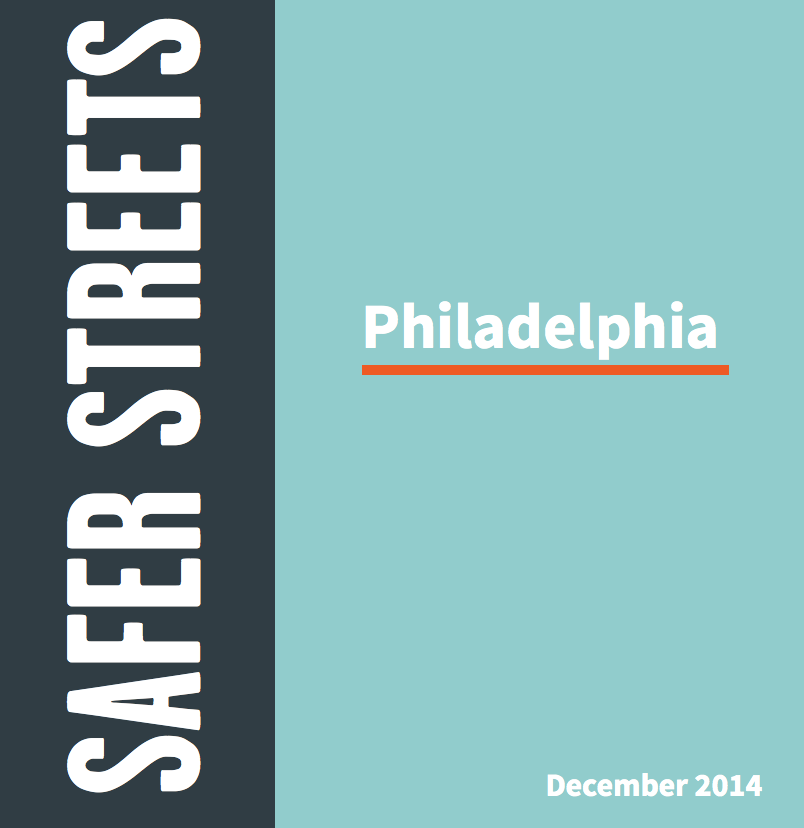 Last week was a bad one for pedestrians crossing busy streets in Philadelphia and its surrounding areas.
Last week was a bad one for pedestrians crossing busy streets in Philadelphia and its surrounding areas.
On December 1, a man in his mid-40s was struck by a car on Cottman Avenue in Northeast Philadelphia. Another 40-year-old man was killed on Roosevelt Boulevard this past Saturday after being hit by an alleged drunk driver.
There were at least seven such crashes involving pedestrians in the Greater Philadelphia area over the last seven days.
Each incident is tragic, preventable, and not necessarily surprising.
According to Safer Streets, a new report released today by the Bicycle Coalition of Greater Philadelphia, 35 percent of 94 people killed in traffic in 2013 (about one death every 90 hours) in Philadelphia were pedestrians.
Pedestrians are the most vulnerable citizens on the road, and over the last five years, things have gotten more dangerous for them in Philadelphia, even while traffic death rates for drivers and bicyclists have gone down. This is unacceptable and reversable.
In addition to implementing the Complete Streets Policy Philadelphia City Council adopted in 2012, we believe it is imperative that the City embark on an effort to implement a targeted program to address dangerous locations in the cities with the goal of reducing all traffic injuries and fatalities by 50 percent by 2020—with the eventual goal of zero deaths, also known as a “Vision Zero” policy.
Crashes involving pedestrians, bicyclists and drivers cost the city about $1 billion per year—each road fatality averages out to $6.35 million, and each major injury is about $1.39 million, when costs associated with hospital bills, funerals, and damaged vehicles are taken into account.
Due to current funding and political realities, Philadelphia’s streets are dated and in desperate need of repair. The next mayor of Philadelphia needs to make safer and updated streets a high priority in order to vastly reduce traffic deaths within her or his administrative tenure.
Philadelphia is not investing enough in maintaining its street network. For the past several years, the city has had to divert a significant portion of its paving budget to upgrade curb cuts in order to meet federal requirements. Consequently, the amount of capital dollars put toward paving streets has declined precipitously since 2009. This lack of resources for the Streets Department has resulted in 900 miles of backlogged streets to be paved.
The streets Dept. needs to pave 130 miles of roads, annually, to maintain its streets in good repair. By Fiscal Year 2016, the paving budget needs to be doubled, or more, to get there.

This problem becomes a bit more infuriating when you see what other cities are investing in their streets or public works departments to carry out the task of making streets safer. In fact, Philadelphia spends less—much less—per capita of its operating budget than many of our peer cities. Baltimore invests $143 per capita on its streets department operating budget; Pittsburgh puts in $64; Chicago: $20.
Then there’s Philadelphia. We invest just $16 of operating funds on the Streets Department, per capita. As a percentage of the city budget, that’s just 0.7 percent. And it is on a downward trend.
For cyclists, who are additionally vulnerable road users, cities across the country have spiked in their dedication for bike lanes since 2008, while Philadelphia’s lane-building efforts have begun to stagnate.
Philadelphia is one of the only major cities in the U.S. without any physically protected bike lanes. In fact, 22 other cities have built protected lanes, including Washington, D.C., Seattle, Boston, Atlanta, Pittsburgh, New York and Denver. Philadelphia and Detroit count as two of the only major metropolitan areas without protected lanes.
As for total lanes? Philadelphia has painted 36.2 since 2008. That’s not bad, but when compared to our peer cities, like New York (175.4 miles since 2008), Boston (81), Chicago (55.8), Pittsburgh (49) and Baltimore (39.4), it’s behind the pack. Granted, Philadelphia installed many more lanes previous to 2008 than most of its peer cities, but it should pick up the pace to close the many remaining gaps in the bikeway network.

Philadelphia will launch public bike share, in Spring 2015, which will add many more bicyclists to city streets. Increasing the installation rate of bike lanes and adding new protected bike lanes is needed to accommodate the current and soon-to-increase number of people bicycling for transportation in Philadelphia.

A Vision Zero policy, like that recently implemented by New York City Mayor Bill de Blasio, would help Philadelphia become a safer, more transit-friendly city—and, therefore, more competitive and desirable.
A large part of making the streets safer for pedestrians, bicyclists and drivers would be boosting the operating and capital budget of the underfunded Streets Department, and dedicating 15 miles per year to bike lanes and protected lanes in addition to adding safety measures to make dangerous intersections less dangerous. With a $1 million per year investment, bikes lanes can provide safe places to bicycle, help calm traffic on city streets and, as evidenced by Spruce and Pine Streets in Center City, reduce crashes significantly.
The financial benefits of crash reduction will far outpace the expenditure. If the next mayor is serious about reducing the number of headlines about deadly crashes, s/he needs to make Vision Zero a priority.
